
Where you are in the solar system changes just how much of an effect the Sun has on you. For Earth, the Sun can cause bright aurorae that can extend down into the mid-latitudes. For comets, the changing distance to the Sun is what gives us cometary tails. But if a larger body was moved from the outer solar system to the inner, that distance to the Sun has different effects.
Scientists trying to understand the composition of the thin, misty atmosphere on Ceres have now discovered that the dwarf planet likely formed in the outer solar system and was moved inward. The early days of planetary formation were turbulent times, with Jupiter and Saturn vying for space, ice giants like Uranus and Neptune getting pushed outward or even yeeted out of the solar system, and smaller bodies bouncing around like billiard balls as gravitational forces pulled on them in every direction. In the journal Icarus, a team of researchers explains how they used computer models to work through their theory that Ceres formed farther out.
Let’s start at the beginning. Ceres, as observed by the Dawn mission, turns out to have quite a bit of ammonia in that thin mist, which is caused by the warmth of the Sun’s light. That mist comes up from below the surface, and it’s actually a mix of water and ammonia. And then there are all those icy deposits at the bottom of the craters on Ceres. But asteroid belt bodies don’t tend to have any sort of ice. They’re dry and dusty. And that’s why this team wanted to see if Ceres possibly formed elsewhere.
That’s where these huge computer models came in. The team started with the assumption that Ceres was a planetesimal in its own right – those bits of rock and gas and dust thought to be the building blocks of larger bodies. As for the result of the simulations, lead author Rafael Ribeiro de Sousa explains: Our simulations showed that the giant planet formation stage was highly turbulent, with huge collisions between the precursors of Uranus and Neptune, ejection of planets out of the Solar System, and even invasion of the inner region by planets with masses greater than three times Earth’s mass. In addition, the strong gravitational disturbance scattered objects similar to Ceres everywhere. Some may well have reached the region of the Asteroid Belt and acquired stable orbits capable of surviving other events.
On top of that discovery, the team’s simulation also found that there were at least 3,600 Ceres-like objects in the early solar system out beyond the orbit of Saturn. Statistically, that improved the chances that Ceres was formed farther out and pushed inward by all the chaos. But the chemical signatures seal the deal. Ceres is too much like objects formed beyond the Frost Line to have started off in the asteroid belt.
More Information
Agência FAPESP press release
“Dynamical origin of the Dwarf Planet Ceres,” Rafael Ribeiro de Sousa et al., 2022 March 25, Icarus




 Join the Crew!
Join the Crew!
 Escape Velocity Space News
Escape Velocity Space News
0 Comments